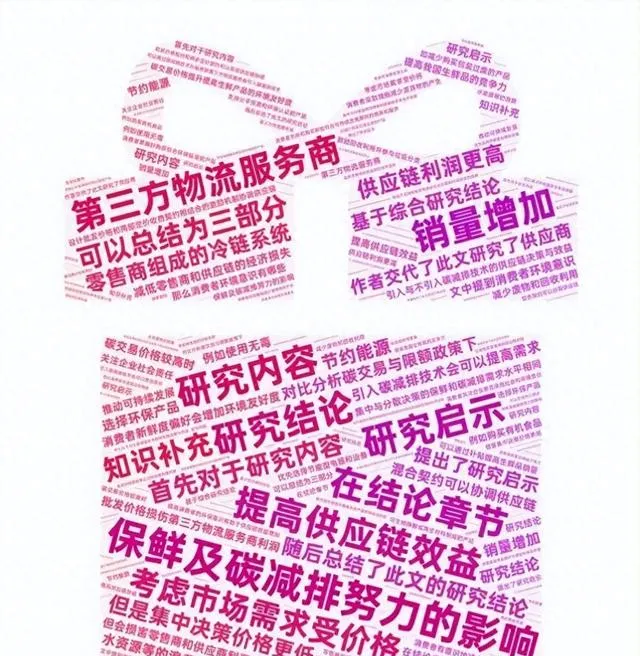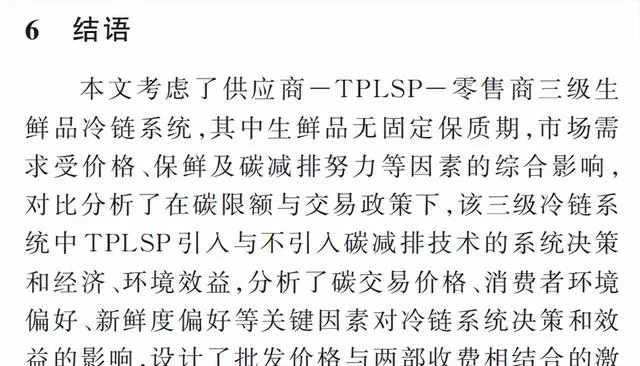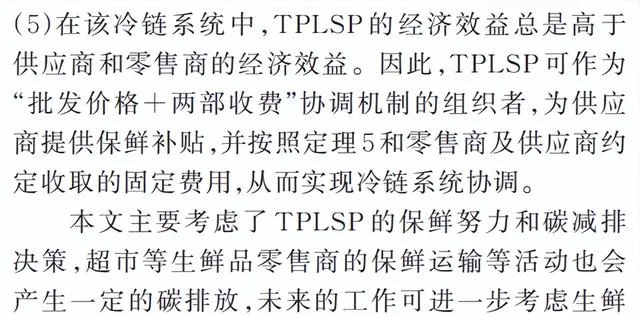
分享兴趣,传播快乐,增长见闻,留下美好。
亲爱的您,
这里是LearingYard学苑!
今天小编为大家带来
【考虑保鲜努力与碳减排努力的生鲜品三级冷链最优决策与协调】结论。
欢迎您的用心访问!
Share interest, spread happiness,
increase knowledge, and leave beautiful.
Dear you,
this is the LearingYard Academy!
Today, the editor brings you
Optimal decision-making and coordination of the three-stage cold chain of fresh products considering preservation efforts and carbon reduction efforts.
Welcome to visit!
本期推文将本通过思维导图,精读内容,知识补充三个板块,展示期刊论文【考虑保鲜努力与碳减排努力的生鲜品三级冷链最优决策与协调】结论,请读者跟着小编一起来学习吧!
This tweet will supplement three ps by mind mapping, intensive reading, and knowledge, and show the conclusion of the journal paper "Optimal decision-making and Coordination of the three-level cold chain of fresh products considering preservation efforts and carbon reduction efforts". Please follow the Xiaoban to learn together!
✦ +
+
思维导图

✦ +
+
精读内容
在结论章节,可以总结为三部分,研究内容,研究结论,研究启示。
首先对于研究内容,作者交代了此文研究了供应商、第三方物流服务商、零售商组成的冷链系统。考虑市场需求受价格、保鲜及碳减排努力的影响,对比分析碳交易与限额政策下,引入与不引入碳减排技术的供应链决策与效益,设计批发价格和两部定价收费契约相结合的激励机制协调供应链。
In the conclusion chapter, it can be summarized into three parts: research content, research conclusion and research enlightenment.
First of all, for the research content, the author explains that this paper studies the cold chain system composed of suppliers, third-party logistics service providers and retailers. Considering the impact of market demand on price, preservation and carbon emission reduction efforts, this paper compares and analyzes the supply chain decisions and benefits of introducing and not introducing carbon emission reduction technology under the carbon trading and cap policy, and designs an incentive mechanism combining wholesale price and two-part pricing and charging contract to coordinate the supply chain.

随后总结了此文的研究结论:1.引入碳减排技术会可以提高需求,提高供应链效益。
Then it summarizes the research conclusions of this paper: 1. The introduction of carbon emission reduction technology can increase demand and improve supply chain efficiency.

2.集中与分散决策的保鲜和碳减排需求水平相同,但是集中决策价格更低,销量增加,供应链利润更高。
2. The demand level of preservation and carbon emission reduction of centralized and decentralized decision-making is the same, but the price of centralized decision-making is lower, sales volume is increased, and supply chain profits are higher.

3.批发价格损伤第三方物流服务商利润,混合契约可以协调供应链。
3. Wholesale price damages the profits of third-party logistics service providers, and hybrid contracts can coordinate the supply chain.

4.碳交易价格提升提高生鲜产品的环境友好度,但会损害零售商和供应商利润。消费者新鲜度偏好会增加环境友好度。
4. Higher carbon prices improve the environmental friendliness of fresh products, but will hurt the profits of retailers and suppliers. Consumer preference for freshness will increase environmental friendliness.

基于综合研究结论,提出了研究启示。1.可以通过碳减排技术补贴鼓励第三方物流服务商引入碳减排技术,提高我国生鲜品的竞争力。
Based on the comprehensive research conclusions, the research enlightenment is put forward. 1. Carbon emission reduction technology subsidies can be used to encourage third-party logistics service providers to introduce carbon emission reduction technology to improve the competitiveness of fresh products in China.

2.碳交易价格较高时,可以通过补贴提高生鲜品销量,减低零售商和供应链的经济损失。
2. When the carbon trading price is high, the sales volume of fresh products can be increased through subsidies to reduce the economic losses of retailers and supply chains.

3.提高消费者的环保意识有助于供应链效益增加。
3. Improving consumers' environmental awareness contributes to the increase of supply chain efficiency.

4.批发价格契约和两步定价契约可以实现供应链协调。
4. Wholesale price contract and two-step pricing contract can realize supply chain coordination.


✦ +
+
知识补充
文中提到消费者环境意识,那么消费者环境意识有哪些?
1. 节约能源:消费者有意识地减少电力、水资源等的浪费,优先选择节能型电器和设备。
2. 减少废物和回收利用:消费者采取措施减少废弃物的产生,如减少购买包装过度的产品,鼓励回收利用并参与垃圾分类。
3. 选择环保产品:消费者更偏好购买符合环保标准的产品,例如使用无毒、可生物降解或再生材料制成的产品。
4. 推动可持续发展:消费者支持和购买那些符合可持续发展原则的商品和服务,例如购买有机食品、支持公平贸易和环保认证的产品。
5. 关注企业社会责任:消费者关注企业是否承担社会和环境责任,倾向于选择那些具有良好社会形象和环保政策的品牌。
The article mentions consumer environmental awareness, then what is consumer environmental awareness?
1. Energy conservation: Consumers consciously reduce the waste of electricity, water resources, etc., giving priority to energy-saving appliances and equipment.
2. Waste reduction and recycling: Consumers take steps to reduce waste generation, such as reducing purchases of over-packaged products, encouraging recycling and participating in waste sorting.
3. Choose eco-friendly products: Consumers prefer to buy products that meet environmental standards, such as those made from non-toxic, biodegradable or recycled materials.
4. Promote sustainability: Consumers support and purchase goods and services that comply with sustainable principles, such as buying organic food, supporting fair trade and environmentally certified products.
5. Pay attention to corporate social responsibility: consumers are concerned about whether enterprises undertake social and environmental responsibility, and tend to choose brands with good social image and environmental protection policies.
今天的分享就到这里了。
如果您对今天的文章有独特的想法,
欢迎给我们留言,
让我们相约明天。
祝您今天过得开心快乐!
That's it for today's sharing.
If you have a unique idea about today’s article,
welcome to leave us a message,
let us meet tomorrow.
I wish you a nice day !
参考资料:DeepL翻译,知乎,百度
参考文献:马雪丽, 赵颖, 柏庆国等. 考虑保鲜努力与碳减排努力的生鲜品三级冷链最优决策与协调 [J]. 中国管理科学, 2023, 31(09): 52-61.
本文由LearningYard学苑整理发出,如有侵权请在后台留言!
文字 | clear
排版| clear
审核| Young











